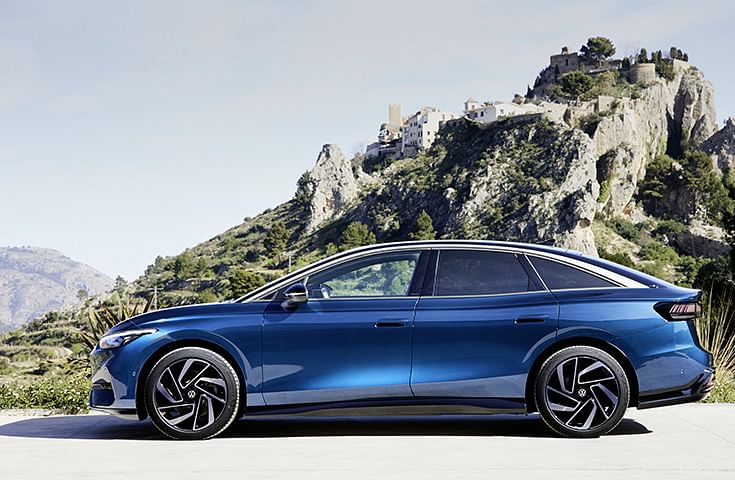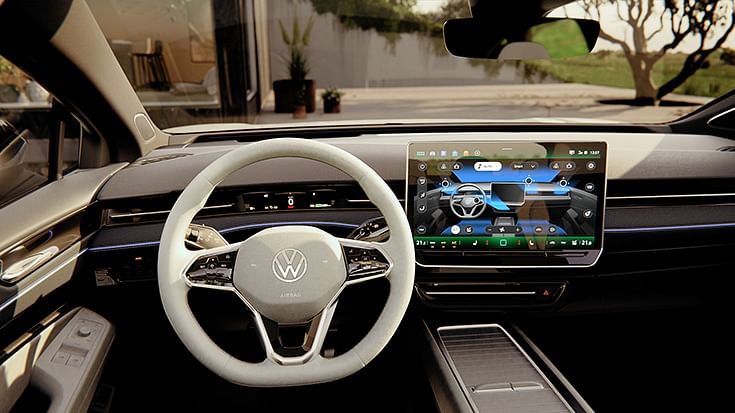Volkswagen reveals ID 7 sedan with 700km range
The ID 7, which has a claimed WLTP range of 700km, can sprint from 0-100kph in around 6 seconds in its top-spec Pro S variant; rivals the likes of Tesla Model 3, Hyundai Ioniq 6 and Polestar 2.
Volkswagen has taken the wraps off the ID 7 electric sedan, which is the German brand’s answer to the indomitable Tesla Model 3. The Volkswagen ID 7 is a large, sleek sedan that is big on luxury appeal in a bid to bolster VW’s share of the crucial executive EV market. The ID 7 will go on sale in Europe and China in late 2023, followed by North America in 2024.
Claimed to have been designed "for long distances", the Volkswagen ID 7 touts a WLTP-claimed range of up to 700km (beating its Californian rival) in its range-topping Pro S guise, which comes with a new 82kWh battery pack that's not in use by any Volkswagen EV. Along with being VW's longest-range EV, the ID 7 Pro S will also be its fastest charging, capable of topping up at speeds of up to 200kW.
A smaller 77kWh battery – familiar from the ID 3, ID 4, ID 5 and ID Buzz – will be offered in the ID 7 Pro, which has a claimed range of 615km and is capable of charging at up to 170kW.
At debut, both variants will be available in single-motor, rear-wheel-drive guise – using a newly developed motor and single-speed gearbox claimed to boost efficiency and power delivery compared to the firm's current EVs. It's a substantially more potent unit than the ones used by any RWD Volkswagen EV so far, making 286hp and 545Nm to give a 0-100kph time of around 6.0 seconds in the quickest variant.
An even faster, twin-motor GTX version will be launched later, which means the ID 7's powertrain line-up will ultimately mirror that of its rivals – Polestar 2, Tesla Model 3 and Hyundai Ioniq 6 rivals.
Dimensions and exterior design
Measuring nearly five metres long with a wheelbase of around three metres, the ID 7 is larger than the Volkswagen Passat to which it serves as an indirect electric alternative. It is, in fact, closer in size to the Volkswagen Arteon luxury sedan, which bowed out in 2016.
As for the design, it’s a traditional three-box shape with rather fuss-free surfacing. Up front, the ID 7 wears sleek, wraparound headlamps that are connected via an LED light bar with the VW logo sitting in the middle. The swooping nose flows down into the front bumper that houses a central air intake and is slightly contoured towards the edges.

In profile, the ID 7 is characterised by two strong character lines – one just below the window line and the other towards the base of the doors. The upper character line flows right from the front fenders along the length of the car to meet the tail-lamps at the rear. There’s also a prominent chrome trim above the window line. At the rear, the ID 7 gets a full-width LED light bar, a fastback-like roofline and a rather clean dual-tone rear bumper.
Interiors and features
The cabin majors on practicality, but various touches ramp up the ID 7's luxury credentials, including a panoramic roof that switches from opaque to transparent at the touch of a button, optional massage seats, an augmented reality heads-up display and a 15.0-inch touchscreen infotainment running a heavily overhauled iteration of Volkswagen's MIB software platform.
 Volkswagen is keen to emphasise the focus it has placed on making this new infotainment platform – shared with the facelifted ID 3 – easy to use. There is a new direct-access bar at the top of the touchscreen for quick access to core functions. For example, the main menu can be opened without closing any app that's in use, and the home screen can be configured to show icons for a driver's most commonly used apps. The main climate controls are now permanently hosted at the bottom of the screen to avoid scrolling on the move.
Volkswagen is keen to emphasise the focus it has placed on making this new infotainment platform – shared with the facelifted ID 3 – easy to use. There is a new direct-access bar at the top of the touchscreen for quick access to core functions. For example, the main menu can be opened without closing any app that's in use, and the home screen can be configured to show icons for a driver's most commonly used apps. The main climate controls are now permanently hosted at the bottom of the screen to avoid scrolling on the move.
Overall, the design is quite simple and minimalistic with a variety of materials and textures used. The neatly integrated AC vents in the dashboard look quite nice, but the absolute lack of physical buttons, even for the most basic functions could be an irritant to some.
Copyright (c) Autocar UK. All rights reserved.
RELATED ARTICLES
Skoda begins sale of made-in-India CKD Kushaq in Vietnam
Before production started, pre-series Kushaq vehicles covered over 330,000 kilometres on a variety of Vietnamese roads a...
Six Japanese companies join forces to expand use of recycled materials in new vehicles
Denso, Toray Industries, Nomura Research Institute, Honda Motor, Matec Inc and Rever Corporation have set up the BlueReb...
BYD selects Voestalpine as steel supplier for its Hungarian plant
The announcement of the Austrian steelmaker as a supplier demonstrates BYD’s strategic plan to source from high-quality,...





 By Autocar Professional Bureau
By Autocar Professional Bureau
 18 Apr 2023
18 Apr 2023
 6817 Views
6817 Views






















